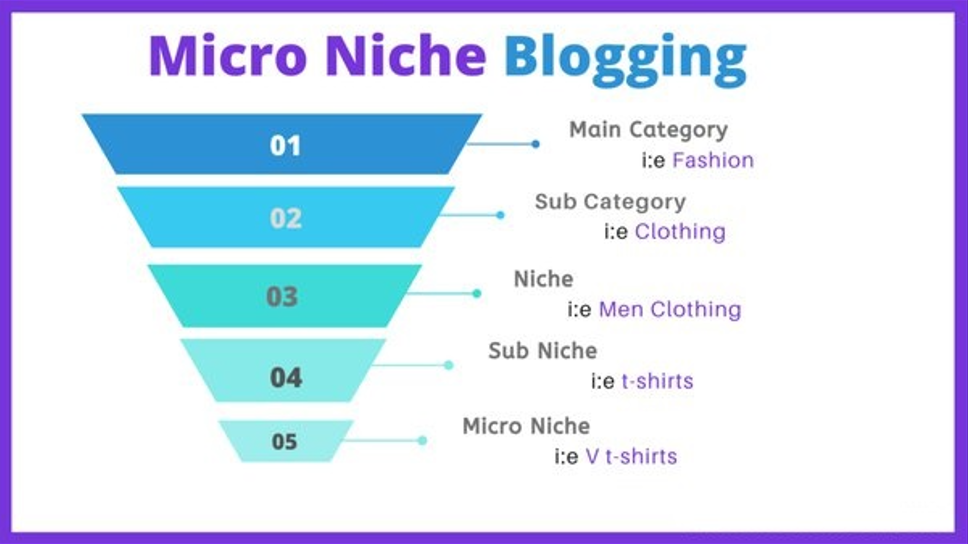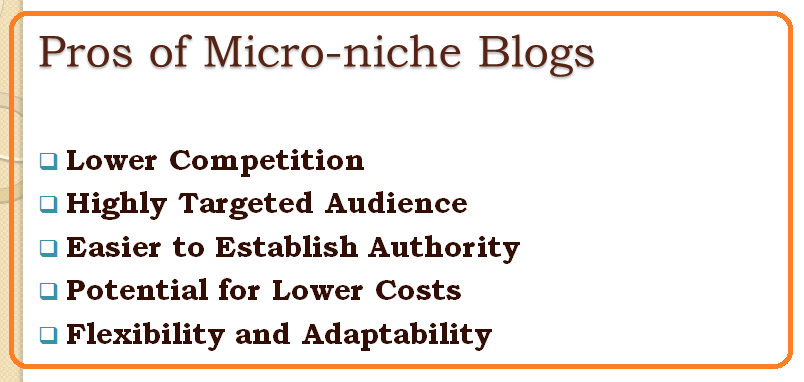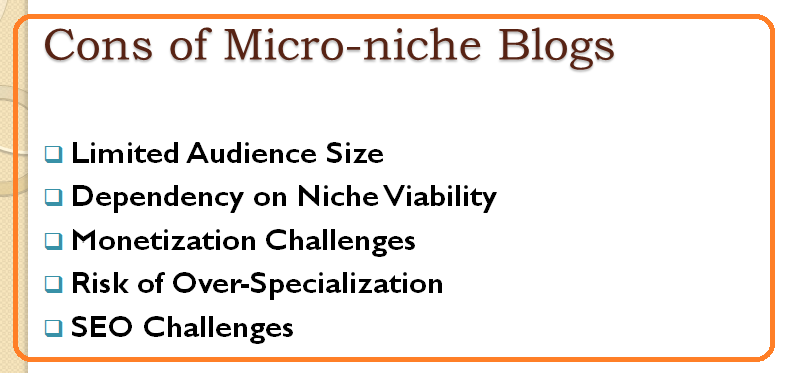In the dynamic landscape of online content creation in 2025, the concept of micro-niche blogs has emerged as a powerful strategy for individuals seeking not only to share their passion but also to generate sustainable profits. A micro-niche blogs is characterized by its laser-focused approach, honing in on a specific topic or subtopic within a broader niche. As we delve into the intricacies of this specialized form of blogging, it becomes apparent that success hinges on meticulous research, quality content creation, and effective monetization strategies.
Distinguishing between general, niche, and micro-niche blogs is crucial for understanding the unique advantages and challenges associated with each. These sites, by their very nature, cater to a more select audience, offering a personalized and deeply engaging experience. This micro-targeting, while potentially limiting in reach, fosters a sense of community and authority within the chosen subject matter.
Table of Contents
What is a Micro-niche Blogs?
A micro-niche blogs are like a super-focused website that talks about one very specific thing in a larger category. Unlike big websites that cover a lot of topics, micro-niche blogs zoom in on just one subject. This helps them connect with people who are really into that specific topic.
The cool thing about these blogs is that they can become experts in that one thing they talk about. Because they go deep into the details, they attract a special group of people who are super interested in that topic. It’s like having a club for people who love exactly what the site is about.
These sites work well in areas where there’s a lot of competition. Instead of trying to compete with big websites, micro-niche blogs find a smaller, untapped audience. Even though the audience might be smaller, the people are really passionate about the topic.
So, a micro-niche blogs are like a focused expert in a specific area, creating a tight-knit community of people who share a strong interest in that particular subject.

What’s the difference between a general blogs, niche blogs, a micro-niche blogs?
In the vast landscape of websites, three distinct categories emerge – general blogs, niche blogs, and micro-niche blogs – each serving unique purposes.
A general blog is like a digital department store, offering a wide variety of content across numerous topics. It caters to a broad audience but may struggle to deeply engage with specific interests.
On the other hand, a niche blognarrows its focus, homing in on a specific subject within a larger category. It’s like a specialized boutique within the digital marketplace, attracting a more targeted audience with shared interests. While broader than a micro-niche, a niche blog still maintains a level of specialization.
A micro-niche blogs take there specialization to the next level. It’s like a tiny, highly specialized shop that zooms in on a very specific topic within a niche. These blogss cater to a very select audience, providing in-depth content and fostering a sense of community among those deeply interested in the minutiae of a particular subject.
In summary, a general blog is like a department store, a niche blog is a specialized boutique, and a micro-niche blogs are tiny, highly focused shop catering to a very specific audience.
How to make money with micro-niche blogs?
Making money with a micro-niche blogs is achievable by focusing on a few key strategies:
Affiliate marketing
Affiliate marketing is a powerful method for monetizing your micro-niche blogs. In this strategy, you partner with companies or individuals related to your niche and promote their products or services on your site. When your visitors click on the affiliate links provided by these partners and make a purchase, you earn a commission. Affiliate
The key to successful affiliate marketing lies in selecting products or services that align seamlessly with your micro-niche content. It’s essential to maintain authenticity and only endorse products that you genuinely believe will benefit your audience. Trust is crucial, and your recommendations should reflect a genuine desire to provide value to your readers.
To get started with affiliate marketing, sign up for affiliate programs offered by companies in your micro-niche. Platforms like Amazon Associates, ShareASale, or ClickBank are popular choices. Once accepted into these programs, you’ll receive unique affiliate links that track the traffic and sales generated from your site.
Incorporate these affiliate links naturally within your content, ensuring they enhance the user experience rather than disrupt it. You can use product reviews, tutorials, or recommendation lists to seamlessly integrate these links.
Regularly assess the performance of your affiliate marketing efforts by tracking clicks, conversions, and commissions. Adjust your strategy based on what works best for your micro-niche audience, and over time, you can build a reliable income stream through effective and ethical affiliate marketing on your micro-niche blogs.
Google AdSense
Google AdSense and other advertising networks present another avenue for making money with your micro-niche blogs. It, in particular, is a widely-used program that allows website owners to display ads on their site and earn money when visitors interact with these ads.
To get started with Google AdSense, you need to apply and, once approved, integrate ad code into your micro-niche blogs. Google’s algorithms then display relevant ads based on your content and your visitors’ interests. You earn money through a combination of cost-per-click (CPC) and cost-per-thousand-impressions (CPM) models, meaning you get paid when users click on the ads or when the ads are simply viewed.
Other advertising networks, such as Media.net and AdThrive, also offer opportunities to monetize your micro-niche blogs through display ads. Similar to Google AdSense, these platforms work by displaying targeted ads, providing you with revenue based on user interactions.
When implementing ads, it’s crucial to strike a balance between monetization and user experience. Carefully consider the placement and number of ads to avoid overwhelming your audience and detracting from the quality of your content. Regularly monitor your ad performance and adjust your strategy to optimize revenue without compromising the integrity of your micro-niche blogs.
Sell your own products or services:
Selling your own products or services is a direct and potentially lucrative way to make money with your micro-niche blogs. This strategy allows you to leverage your expertise and unique insights within your niche to create valuable offerings tailored to your audience.
If you have specialized knowledge or skills related to your micro-niche, consider developing and selling digital products like e-books, guides, or online courses. These products provide tangible value to your audience while allowing you to monetize your expertise. Platforms such as Gumroad, Teachable, or even your own e-commerce website can facilitate the sale and delivery of these digital goods.
Physical merchandise is another avenue for monetization. Create and sell branded merchandise or products related to your micro-niche. This could include items like T-shirts, mugs, or any merchandise that resonates with your audience. Utilizing print-on-demand services can simplify the production and fulfillment process.
Offering consulting services or personalized advice is yet another way to monetize your expertise. If your micro-niche involves a service-oriented aspect, consider providing one-on-one consultations, workshops, or coaching sessions. This not only generates income but also positions you as a go-to expert in your field.
When selling your own products or services, maintaining transparency and ensuring the quality of what you offer is paramount. Establishing trust with your audience is key to building a sustainable income stream through direct sales on your micro-niche blogs.
Choosing the right keywords is crucial for attracting the right audience. Research and use keywords relevant to your micro-niche to improve your site’s visibility on search engines, bringing in more potential income.
In essence, making money with micro-niche blogs involves a mix of affiliate marketing, advertising, selling your products, and strategic keyword use. By combining these approaches and staying true to your niche, you can turn your passion into a profitable venture.
What are the pros and cons of micro-niche blogs?
In the expansive world of online content creation, the concept of micro-niche blogs has gained prominence, offering a targeted approach to cater to specific audiences. Like any strategy, building micro-niche blogs come with its own set of pros and cons.
Pros of Building a Micro-Niche Blogs:
Lower Competition:
Micro-niche blogs operate in specialized, often overlooked corners of broader industries. This lower competition can make it easier to establish authority and rank higher on search engines, driving organic traffic.
Highly Targeted Audience:
The specificity of micro-niche blogs allows for a highly targeted audience. This means that the people who find and engage with your content are genuinely interested in the niche, leading to more meaningful interactions and potentially higher conversion rates.
Easier to Establish Authority:
By focusing on a narrow topic, you can position yourself as an expert within that micro-niche more quickly. Users looking for in-depth information are more likely to trust and return to a site that demonstrates expertise in a particular subject.
Potential for Lower Costs:
Micro-niche blogss often require less investment in terms of content creation, marketing, and overall maintenance. This can be advantageous for individuals or small businesses with limited resources.
Flexibility and Adaptability:
Smaller niches often allow for more flexibility and adaptation to changes. As trends shift or new topics emerge within the micro-niche, a smaller site can respond more quickly than larger, more generalized sites.

Cons of Building a Micro-Niche Blogs:
Limited Audience Size:
The very specificity that attracts a targeted audience can also limit the overall size of your potential audience. This could result in slower growth and fewer opportunities for expansion.
Dependency on Niche Viability:
The success of micro-niche blogs is heavily reliant on the viability and longevity of the chosen niche. If the niche loses relevance or interest over time, the site may struggle to sustain itself.
Monetization Challenges:
Generating income can be challenging for micro-niche blogs, especially if the audience is too small or not engaged enough. Monetization options like advertising may be limited compared to more generalized sites.
Risk of Over-Specialization:
Focusing too narrowly on a micro-niche can be a double-edged sword. While specialization is beneficial, there’s a risk of becoming too specific, alienating potential audience members, or running out of relevant content ideas.
SEO Challenges:
Despite the potential for easier ranking due to lower competition, micro-niche blogs may face challenges in attracting a significant amount of organic traffic. It’s crucial to strike a balance between specialization and broader appeal.

Building micro-niche blogs involves a careful consideration of the trade-offs. While the advantages of lower competition, a highly engaged audience, and easier authority establishment are appealing, the challenges of a limited audience, dependency on niche viability, and potential monetization issues must be acknowledged.
Ultimately, the success of a micro-niche blogs lies in a combination of strategic planning, high-quality content creation, and adaptability. By carefully weighing the pros and cons and implementing a well-rounded approach, content creators and entrepreneurs can harness the power of micro-niche blogs to carve out a unique space in the digital landscape.
Conclusion
In conclusion, the journey of building and maintaining a micro-niche blogs presents a dynamic landscape of opportunities and challenges. The merits of easier authority establishment, targeted audience engagement, and lower competition are undeniable advantages that can position a micro-niche blogs for success. However, the potential pitfalls of a limited audience size, dependency on niche viability, and monetization hurdles necessitate a strategic and thoughtful approach.
Success in the realm of micro-niche blogs hinges on finding the delicate balance between specialization and broader appeal. While the focused content can attract a dedicated following, creators must remain vigilant about adapting to changing trends and avoiding over-specialization.
Ultimately, the decision to embark on a micro-niche blogs venture should be informed by a thorough understanding of the chosen niche, a commitment to consistent and high-quality content creation, and a willingness to adapt to the evolving digital landscape. As the online space continues to evolve, micro-niche blogs hold the potential to not only capture the attention of a specific audience but also to carve out a unique and profitable space in the vast world of digital content.
FAQs about micro-niche blogs in 2025
What are a Micro-Niche Blogs, and How Does It Differ from a Regular Blog?
A micro niche blog is a specialized website that focuses on a very narrow and specific topic within a broader niche. Unlike regular blogs that cover a wide range of subjects, micro niche blogs delve deeply into a particular area, catering to a targeted audience. For example, while a regular travel blog might cover various destinations, a micro niche travel blog could exclusively focus on budget-friendly travel tips for solo backpackers.
How Can I Identify a Profitable Micro-Niche Blogs for My Blog in 2025?
To identify a profitable micro niche, consider using keyword research tools to uncover topics with a balance of low competition and high search volume. Look for niches where there is a specific problem or interest that hasn’t been extensively covered. Analyze trends, industry news, and audience needs to pinpoint a niche that aligns with your passion and has the potential for profitability.
What Monetization Strategies Work Best for Micro-Niche Blogs?
Micro niche blogs offer various monetization avenues, such as affiliate marketing, Google AdSense, sponsored content, and selling digital products. Affiliate marketing involves promoting products or services and earning a commission on sales. Google AdSense allows you to display ads on your site and earn revenue based on clicks and impressions. Additionally, creating and selling digital products, like e-books or online courses, can be a lucrative income stream.
How Important is SEO for a Micro Niche Blog’s Success?
SEO (Search Engine Optimization) is crucial for the success of a micro niche blog. Optimizing your content for relevant keywords helps improve your blog’s visibility in search engine results, attracting organic traffic. Use proper meta tags, quality backlinks, and focus on creating high-quality, informative content that addresses the specific needs of your target audience. Regularly update your content and stay informed about SEO best practices to maintain and improve your blog’s rankings.
Can I Run a Micro-Niche Blogs Part-Time and Still Make a Profit?
Yes, running a micro niche blog part-time is feasible. Consistency and strategic time management are key. Plan your content creation, marketing, and engagement efforts efficiently. Automate repetitive tasks, utilize scheduling tools for social media, and prioritize high-impact activities. With dedication and a well-executed plan, you can successfully run a profitable micro niche blog while balancing other commitments.
More Resources
- Unlock Google Sitelinks: How Do You Get Them Fast in 2025
- Understanding Dedicated Server Hosting in 2025: A Comprehensive Guide
- Crafting Homepage SEO: The Backbone of Online Visibility in 2025
- Mastering Mobile SEO Optimization: Essential Strategies for Websites in 2025
- Topical Authority SEO: How to Boost Traffic on Your Website in 2025